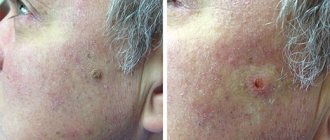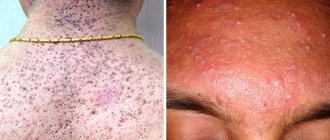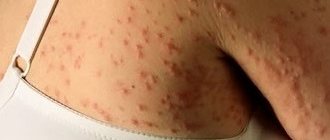If the face is our passport, then the business card is our hands. When your hands dry out and crack, even with an impeccable manicure, the overall impression of the whole “picture” deteriorates. Dry hand skin is a problem that almost every woman tries to cope with with varying degrees of success. Very dry hand skin is a cause for serious concern. If the skin on your hands dries and cracks, and deep cracks from which blood sometimes comes out create discomfort, then it’s time to sound the alarm. Let's find out how to get rid of dry skin on your hands and what to do if the skin on your hands is cracking.
Why does the skin on my hands dry out?
Dry hand skin is a complex phenomenon that can be accompanied by a feeling of tightness and discomfort, peeling of the skin of the fingers or palms. The answer to the question of why the hands of women and men peel may lie in the area of both external and internal factors.
External factors
So, why do your hands peel - several possible external reasons:
- seasonal changes and climatic factors (temperature changes, cold, wind, hot sun);
- dry indoor air due to the operation of heating appliances or air conditioning systems;
- frequent washing and/or active disinfection of hand skin;
- using household chemicals and/or other aggressive substances without gloves;
- incorrectly selected hand skin care or lack thereof.
Internal factors
Dry hand skin can also be associated with internal factors:
- Physiological features: compared to many other areas of the body, the skin of the hands has a thinner lipid layer, is more susceptible to the aging process and may be more vulnerable to aggressive environmental influences.
- Genetic predisposition: hereditary features of the functioning of the hydrolipid mantle of the skin.
- Various diseases: we will not consider them in this article; in this case, consultation with a dermatologist is necessary.
How to care depending on age
The dermis of the hands ages very early. To prevent this from happening too quickly, skin care should be age-appropriate.
The recommendations are as follows:
- 20+. Caring at home at such a young age is not difficult. The base is a hand cream with glycerin substances and fatty acids. It is better to wash with products with a neutral pH, and when cleaning and other work it is important to use special gloves.
- 30+. This requires more effort and responsibility. The dermis begins to lose its tone, becomes less elastic, and reacts more strongly to negative external actions. And to restore it, more manipulations are required than before. It is better to buy creams with antioxidant elements, substances that regenerate cells and normalize blood circulation. Twice a week it is important to perform gentle scrubbing or use products with AHA. Such procedures should be used in parallel with massage.
- 40+. At this age, the dermis is already more vulnerable to external factors: severe cold in winter and scorching sun in summer provoke moisture deficiency and peeling. UV leads to the appearance of age spots, and getting rid of them is very difficult. At this age, it is recommended to include a healthy diet. We must not forget about peeling, masks, paraffin therapy and wraps.
- 50+. When menopause has passed, the dermis becomes thinner and its protective functions become noticeably weaker. It is important to take care at home at this age systematically, every day and persistently, using cosmetic products. Anti-aging products with a high level of nutrients and moisture-retaining substances, natural oils are used. And in the summer - with a protective factor against ultraviolet rays.
For complete and high-quality care for the dermis, you can consult a doctor. In the modern world, professional techniques are used for care:
- peeling with acids: they whiten and fight fine wrinkles;
- paraffin therapy: it makes the epidermis softer;
- mesotherapy: injections of special cocktails with vitamins, peptide substances, amino acids, hyaluronic acid smooth and add shine;
- biorevitalization: hyaluronic acid is injected into the dermis through injections, this provides long-lasting hydration, increases turgor and tones, eliminates wrinkles.
Many methods are used today; the doctor selects treatment individually.
What to do with dry hand skin?
If the skin on your hands has become dry, your palms are flaky, or your hands feel unpleasantly dry, the skin is most likely having difficulty retaining moisture. This can happen if the natural protective barrier of the skin, its hydrolipid mantle, is disrupted.
Repairing cream for very dry hands CeraVe
CeraVe restoring cream for very dry hand skin contains components aimed at strengthening the hydrolipid barrier and intensively moisturizing the skin. Let's look at them in more detail:
Ceramides: these are lipids that help maintain the protective functions of the skin and help restore and strengthen its hydrolipidic barrier.
Hyaluronic Acid: Draws moisture into the upper layers of the skin, helping to maintain hydration for a long time.
Phytosphingosine: is a phospholipid that helps strengthen the skin's own protective functions. It helps reduce moisture loss from the upper layers of the skin and protect it from dehydration.
CeraVe Revitalizing Cream is formulated with MVE technology, a gradual release of active ingredients that helps provide long-lasting hydration to the skin. It is fragrance-free, paraben-free, hypoallergenic and suitable for very dry hands.
Revitalizing hand cream
For very dry skin
Moisturizes dry, chapped hands, helping to restore and strengthen the protective skin barrier.
More details
Features of treatment
Treatment of skin diseases of an allergic nature requires an integrated approach. First of all, therapy should be aimed at the absolute exclusion of harmful pathogens, as well as at improving symptoms. Itching, swelling and redness cause patients severe discomfort, both physiological and emotional. Itchy spots make it difficult to sleep and work fully. In addition, the affected areas disrupt the aesthetics of the skin, so patients often hide them under clothing, which can only aggravate the situation. In addition, allergic reactions on the skin cannot be wetted, so patients are deprived of the opportunity to take a bath, visit the pool or sauna.
To eliminate a rash on the hands, it is necessary to use topical external agents in the form of ointments or creams. In the treatment of allergic dermatoses, drugs based on topical glucocorticosteroids have proven themselves to be effective.[10] Such products have wide application possibilities, since they have several effects on the inflammatory focus:
- anti-inflammatory effect;
- antiallergic effect;
- vasoconstrictor properties;
- antipruritic effect.
One of the representatives of local glucocorticosteroids prescribed for the treatment of allergic dermatoses are the drugs "Akriderm GK".
Features of seasonal care for dry skin
What to do and how to deal with very dry skin in winter and summer? Will basic care methods vary depending on the season? Yes - and now we will tell you how.
Care in autumn and winter
Dry hands in the autumn-winter period is one of the common problems in both women and men. The skin of your hands may peel, suffer from dryness and a feeling of tightness... The following measures will help combat the fact that your palms or fingers are peeling:
- Use special hand products designed for use before going outside, and moisturizing and restorative products after returning home.
- Try not to appear outside without gloves, protect your hands from temperature changes and sharp winds.
- Do not forget to regularly moisturize your hands when in a room where heating devices are operating.
Care in spring and summer
If your hands peel in the warm season, it may also be a matter of incorrectly chosen care, or a possible lack of vitamins and minerals in the diet. Here's how you can try to fix this situation:
- Try not only to moisturize the skin of your hands, but also to protect it from aggressive sun rays using cosmetics with SPF protection.
- Remember to drink enough clean water to prevent general dehydration.
- Watch your diet: eat more vegetables, fruits, fatty fish and other sources of skin-healthy nutrients.
Prevention measures
To preserve the attractive appearance of your skin for many years, you must follow these tips:
- It is recommended to wash your hands only in warm water. Too high a temperature leads to peeling, low temperature leads to loss of elasticity.
- Dry your hands only with clean towels made from natural soft fabrics.
- Every day before going to bed, lubricate the skin with moisturizing creams containing plant extracts, nourishing oils and vitamins.
- Every week it is recommended to make moisturizing masks using pharmaceutical or homemade products.
- Do not expose your hands to frost or wind. For protection, it is recommended to wear warm gloves.
By adhering to these rules, you can significantly improve the appearance of your skin and prevent excessive dryness and flaking.
The positive effect of cosmetic procedures will increase if you supplement them with proper nutrition and quality rest.
TOP 4 rules for caring for dry and very dry hand skin
Here are some general tips and tricks that may help if the skin on your palms and hands is flaking:
- Choose your hand cleanser for daily use carefully. If the skin on your palms and arms is dry, you can pay attention to creamy cleansers labeled “soap-free.”
- If there are no wounds or cracks on the skin of your hands, then 1-2 times a week you can gently scrub the skin of your hands as an option for intensive cleansing. Gentle exfoliation will not only help stimulate the renewal of the upper layers of the skin, but can also make it more receptive to the use of moisturizing and restorative care products.
- If your hands are very dry, try to use specialized care every day - for example, CeraVe restoring cream for very dry skin of hands, which contains components that help restore the skin's own protective functions, moisturize it and strengthen the lipid barrier.
- Don't forget to protect your hands (household gloves) when working with cleaning products and other household chemicals. They often contain alkaline and other aggressive components that can negatively affect the condition of the skin of the hands, causing irritation and dryness.
We hope that this article helped you understand the reasons why your hands may peel, answered questions about what to do with dry fingers, hands and palms, and suggested how you can deal with the problem of dry hands depending on the season!
Daily care
Home care should be systematic. The rules are as follows:
- after the hands have been wet, dry them well and use cream to moisturize;
- Wash your palms only with warm water, not ice or boiling water, especially if the skin is constantly peeling, drying, cracking;
- Brushes should be washed with cleansing agents with a pH no higher than 5;
- after working in the country, you should not wipe off dirt with a hard cloth, wash it carefully several times, and even better, work with gloves;
- When cleaning the house, you should wear rubber gloves - they will protect the dermis from the action of chemicals.
You need to apply the cream every day, morning and evening.








